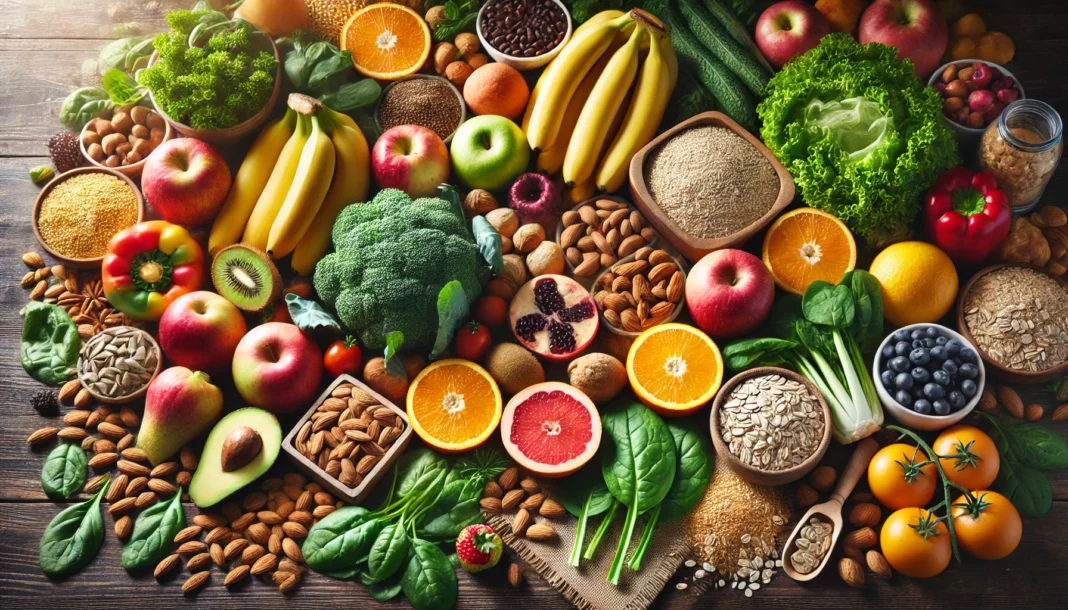In the pursuit of a healthier lifestyle, one of the most impactful changes you can make is adopting a whole food diet. Whole foods are foods that are minimally processed, close to their natural form, and packed with nutrients that promote optimal health. A whole food diet is not just about weight management or body composition; it’s about improving overall well-being, boosting energy, and reducing the risk of chronic diseases.
You may also like: How to Start a Whole Food Plant-Based Diet: A Beginner’s Guide to Healthier Eating
A whole food diet plan focuses on foods that are as close to their natural state as possible. By incorporating a variety of these nutrient-dense foods, you can nourish your body with vitamins, minerals, antioxidants, and fiber while eliminating refined foods and processed sugars that can cause inflammation and metabolic issues. This article explores how to build a whole food diet plan, what healthy whole foods to include, and how making this transition can improve both your physical and mental health.
What Are Whole Foods? Defining Whole Foods and Their Role in a Healthy Diet
Whole foods are foods that are minimally processed or refined and are free from artificial additives, preservatives, and other unnatural substances. This category includes fresh fruits and vegetables, whole grains, legumes, nuts, seeds, and certain animal products when chosen wisely. These foods retain the most nutrients, fiber, and beneficial compounds, making them the foundation of any healthy whole foods diet.
The role of whole foods in a healthy diet goes beyond basic nutrition. They provide your body with the essential nutrients it needs to function at its best, from supporting immune function to maintaining gut health and cognitive performance. A whole foods diet is also linked to better heart health, improved digestive function, and a reduced risk of diabetes and cancer.
To make the most of a whole food diet plan, it’s important to focus on including a variety of whole foods in your meals. This ensures that your body receives the full spectrum of nutrients necessary for optimal health. The first step in building a wholesome food diet is understanding which foods are considered whole foods and how they contribute to overall health.

Healthy Whole Foods to Include in Your Diet Plan
When constructing a whole food diet plan, it’s important to focus on diversity. By including a wide range of whole foods, you provide your body with an array of nutrients that support various aspects of health. Here’s a breakdown of some of the best whole foods to incorporate into your diet for optimal wellness.
Fruits and Vegetables: The Foundation of a Whole Food Diet
Fruits and vegetables are cornerstones of any whole food diet plan. Packed with essential vitamins, minerals, fiber, and antioxidants, they help reduce inflammation, support heart health, and maintain healthy blood sugar levels. Vegetables such as leafy greens (spinach, kale, arugula), cruciferous vegetables (broccoli, cauliflower), and root vegetables (sweet potatoes, carrots) provide a wealth of health benefits, including boosting the immune system and supporting gut health.
Fruits, especially those high in vitamin C, like oranges, strawberries, and kiwis, help to support skin health, boost immunity, and fight oxidative stress. Berries, including blueberries, raspberries, and blackberries, are rich in antioxidants, which can help to prevent cell damage and reduce inflammation in the body. Including a variety of both fruits and vegetables in your meals ensures that you get the vitamins and minerals that your body needs for proper functioning.
Whole Grains: A Vital Source of Fiber and Nutrients
Whole grains are an essential component of a wholesome food diet. Unlike refined grains, whole grains retain their fiber, vitamins, and minerals. Some of the best whole grains to include in your whole food diet plan include quinoa, brown rice, oats, barley, and farro. These grains are excellent sources of fiber, which promotes healthy digestion, helps regulate blood sugar levels, and supports heart health.
Whole grains are also rich in essential nutrients, including B vitamins, iron, and magnesium. These nutrients play important roles in energy production, muscle function, and overall metabolic health. Including a variety of whole grains in your diet ensures you maintain a healthy gut microbiome, which is essential for digestion and overall health.
Legumes: Nutrient-Packed Plant-Based Protein
Legumes, such as beans, lentils, peas, and chickpeas, are another important group of whole foods to include in your diet. They are excellent sources of plant-based protein, fiber, vitamins, and minerals. Legumes are also incredibly versatile and can be incorporated into a variety of meals, from soups and stews to salads and casseroles.
In addition to providing protein, legumes are known to support heart health, regulate blood sugar levels, and promote digestive health. They are also a great alternative to meat for those following a plant-based diet. The high fiber content in legumes can help improve bowel regularity and maintain a healthy gut.
Nuts and Seeds: Healthy Fats and Essential Nutrients
Nuts and seeds are packed with healthy fats, protein, fiber, and essential nutrients. Some of the best nuts and seeds to include in your whole food diet plan include almonds, walnuts, chia seeds, flaxseeds, and sunflower seeds. These nutrient-dense foods support heart health, brain function, and overall well-being.
The healthy fats found in nuts and seeds are primarily unsaturated fats, which are known to lower cholesterol levels and reduce the risk of cardiovascular disease. These foods are also rich in antioxidants, such as vitamin E, which help to protect the body from oxidative stress and inflammation.
Animal Products: Choosing Whole Animal-Based Foods Wisely
While a plant-based whole food diet is incredibly beneficial, some individuals may choose to include animal products in their diet. It’s important to choose high-quality, minimally processed animal products, such as organic, grass-fed meats, wild-caught fish, and free-range eggs. These animal-based foods provide important nutrients such as high-quality protein, omega-3 fatty acids, and vitamin B12.
When including animal products in your whole food diet plan, it’s crucial to focus on quality over quantity. Moderation is key, as excessive consumption of animal products can lead to negative health outcomes. Ideally, animal-based foods should complement a plant-rich diet, rather than dominate it.
Building Your Whole Food Diet Plan: Practical Tips for Beginners
Transitioning to a whole food diet can feel overwhelming at first, but with the right approach, it becomes a sustainable and enjoyable lifestyle. Here are some practical tips to help you build your whole food diet plan:
- Start Slow and Gradual: Instead of completely overhauling your diet overnight, begin by gradually replacing processed foods with whole foods. You might start by adding more fruits and vegetables to your meals, swapping refined grains for whole grains, and incorporating more legumes and nuts into your snacks.
- Meal Prep and Planning: One of the best ways to stick to a whole food diet is by meal prepping. Plan your meals for the week ahead, making sure to include a variety of whole foods from each food group. Preparing your meals in advance helps prevent the temptation to reach for processed, convenience foods when you’re hungry.
- Experiment with New Recipes: A whole food diet plan doesn’t have to be boring or repetitive. Experiment with new recipes that include a variety of whole foods. Try making homemade veggie burgers, soups, and smoothies, or experiment with grain bowls, salads, and plant-based stir-fries. Variety is key to keeping your meals exciting and nutritious.
- Educate Yourself About Whole Foods: Knowing which foods are considered whole foods and which are not is crucial for building a successful whole food eating plan. Be mindful of food labels and avoid products that contain added sugars, artificial ingredients, and preservatives. Focus on fresh, whole ingredients whenever possible.
- Listen to Your Body: A whole food diet should leave you feeling energized, satisfied, and healthy. If you find that certain foods don’t sit well with your digestive system or cause discomfort, consider adjusting your diet accordingly. Everyone’s body is different, and it’s important to pay attention to how foods make you feel.

Frequently Asked Questions (FAQ) About Building a Whole Food Diet Plan
- What are whole foods, and how do they fit into a healthy diet?
Whole foods are minimally processed, natural foods that are as close to their original form as possible. They include fruits, vegetables, whole grains, legumes, nuts, seeds, and, for some, ethically sourced animal products like grass-fed meats and wild-caught fish. These foods provide high levels of essential nutrients such as fiber, vitamins, and minerals while being free from artificial additives, preservatives, or refined ingredients. A whole foods diet supports optimal health by reducing inflammation, stabilizing blood sugar levels, and offering a diverse range of nutrients. When aiming to build a wholesome food diet, focus on variety and nutrient density, ensuring that you’re eating healthy whole foods that nourish your body without the excess calories and chemicals found in processed alternatives.
- Is cheese a whole food?
Cheese, while a natural product, is typically not considered a whole food. Most commercially available cheeses undergo processing, which includes pasteurization, salting, and aging. This process, though it preserves the cheese, alters its nutritional profile. While some artisan or raw milk cheeses may retain more of their original nutrients, they still undergo some degree of processing, making them less of a whole food compared to fresh produce or unrefined grains. If you’re following a whole food eating plan, it’s recommended to focus on whole, plant-based alternatives for most of your meals and limit the intake of dairy products. However, moderate consumption of high-quality cheese can still be a part of a balanced, healthy whole food diet, especially if you choose varieties like raw, grass-fed cheese with minimal additives.
- What foods are good for you when following a whole food diet plan?
When following a whole food diet plan, healthy foods to eat include fresh fruits and vegetables, whole grains like quinoa, brown rice, and oats, as well as legumes such as lentils, beans, and peas. Nuts and seeds like almonds, walnuts, flaxseeds, and chia seeds also make great whole foods, providing healthy fats and protein. These nutrient-dense foods support heart health, improve digestion, and help maintain a healthy weight. Additionally, including healthy fats from sources such as avocados and olive oil, and lean proteins from whole-food-based plant sources like tofu or tempeh, can further enhance the benefits of your whole foods diet. Remember, the key is variety—try to include different types of whole foods from all the food groups to ensure you’re meeting all your nutritional needs.
- What are some examples of whole foods, and how can they be incorporated into meals?
Examples of whole foods include fresh fruits, such as apples, oranges, and berries, vegetables like kale, carrots, and sweet potatoes, and whole grains such as brown rice, quinoa, and farro. Legumes such as black beans, chickpeas, and lentils also count as whole foods, along with nuts and seeds like almonds, chia seeds, and flaxseeds. These whole foods can be incorporated into meals in various ways. For example, you can make a hearty grain bowl with quinoa, roasted vegetables, and a protein source like lentils or chickpeas. A smoothie made with fresh fruit, leafy greens, chia seeds, and unsweetened almond milk can also be an excellent snack or meal. When incorporating these great whole foods, the goal is to use minimally processed ingredients to create balanced meals that support long-term health.
- What is the difference between a whole food diet and a processed food diet?
The primary difference between a whole food diet and a processed food diet lies in the level of refinement and the presence of artificial ingredients. Whole foods are natural and unrefined, providing essential nutrients in their purest form, while processed foods undergo various stages of alteration, often adding preservatives, refined sugars, and unhealthy fats. Eating whole foods means you are consuming foods in their natural state, which helps to maintain the integrity of their nutritional profile. Processed foods, on the other hand, are often stripped of their nutrients and can contribute to chronic health conditions such as obesity, diabetes, and heart disease. By choosing a whole foods diet, you’re prioritizing your health with nutrient-dense foods, which support better digestion, clearer skin, and more sustained energy throughout the day.
- Is Greek yogurt a whole food?
Greek yogurt can be considered a whole food if it is plain, unsweetened, and made with minimal processing. When choosing Greek yogurt, ensure that it’s free from added sugars, artificial flavors, and preservatives, as these elements are common in processed versions. Greek yogurt retains its natural probiotics, protein, and calcium content, which makes it beneficial for gut health and bone strength. However, like other dairy products, it may not fit everyone’s definition of a whole food, especially for those following a plant-based whole food eating plan. For those who prefer plant-based alternatives, options such as coconut or almond milk-based yogurts with no added sugar can provide similar benefits.
- What foods are considered whole foods, and why are they beneficial?
Whole foods include fresh fruits, vegetables, whole grains, nuts, seeds, and legumes. These foods are beneficial because they retain their natural nutrients, providing your body with essential vitamins, minerals, antioxidants, and fiber, which are often lost in processed foods. The health whole foods found in a whole foods diet help reduce inflammation, support digestion, and stabilize blood sugar levels. Unlike refined or processed foods, which may contain empty calories and added sugars, whole foods fuel the body efficiently, promoting long-term health and energy. The increased fiber content in many whole foods also aids in satiety, which can help with weight management and reduce overeating.
- How do I get started with whole food eating for beginners?
For beginners, the best way to start eating whole foods is to focus on gradually replacing processed foods with whole food alternatives. Begin by cleaning out your pantry and fridge of processed snacks, sugary beverages, and pre-packaged meals. Next, stock up on fresh produce, whole grains, legumes, nuts, and seeds, which form the foundation of a wholesome food diet. For meals, start simple with dishes like roasted vegetables, grain bowls, or hearty salads, and experiment with incorporating legumes as a protein source. Whole food eating for beginners is about making small, manageable changes that become sustainable over time. Start with a few meals a week, and slowly increase your intake of whole foods as you get more comfortable with cooking and meal prep.
- What are some whole food diet food list items that support heart health?
To support heart health, focus on including whole foods that are high in fiber, healthy fats, and antioxidants. Examples of great whole foods for heart health include leafy green vegetables, such as spinach and kale, which are rich in vitamins and minerals that support cardiovascular function. Whole grains like oats, barley, and quinoa help lower cholesterol and maintain a healthy blood sugar level. Healthy fats from nuts, seeds, and avocados can reduce bad cholesterol and support overall heart function. Legumes, including beans and lentils, are another excellent choice, as they are high in fiber and protein while being low in saturated fat. These foods work together to improve blood circulation, reduce inflammation, and lower the risk of heart disease.
- What foods are great whole foods to incorporate into my diet to boost energy levels?
To boost energy levels, focus on consuming whole foods that provide a steady release of energy throughout the day. Whole grains like brown rice, oats, and quinoa are excellent sources of complex carbohydrates, which are digested slowly, offering a consistent supply of energy. Fruits such as bananas, apples, and berries provide natural sugars along with fiber, which helps regulate energy levels. Adding nuts and seeds to your meals offers a good balance of healthy fats and protein, sustaining energy without the crash that comes from processed sugars. Hydrating foods, such as cucumbers and oranges, along with leafy greens like spinach, also contribute to maintaining balanced energy levels throughout the day. By incorporating these great whole foods into your daily meals, you can maintain consistent energy while avoiding the spikes and crashes that come from consuming refined or processed foods.

Conclusion: Embracing Whole Food Eating for a Healthier Life
Incorporating whole foods into your diet can have a profound impact on your overall health and wellness. By choosing minimally processed, nutrient-dense foods, you’re providing your body with the essential building blocks it needs for optimal function. A whole food diet plan can help reduce the risk of chronic diseases, promote healthy aging, and support your body’s natural detoxification processes.
Whether you’re just beginning your journey with whole food eating or are looking for ways to refine your current diet, the key is to focus on variety, quality, and balance. By embracing whole foods as the foundation of your diet, you can create a sustainable, health-boosting eating plan that benefits not only your body but also your mind and spirit. With consistent effort and mindful choices, you can unlock the full potential of a whole food diet and enjoy a lifetime of health and wellness.
Further Reading:
11 Simple Ways to Focus on Whole Foods Instead of Clean Eating
whole food lifestyle, clean eating, nutrient-dense foods, unprocessed foods, plant-based nutrition, balanced diet, sustainable eating habits, fresh produce, minimally processed foods, wholesome eating, dietary guidelines, unrefined grains, healthy meal planning, nutrient-rich meals, whole foods menu, natural foods, organic food choices, healthy eating habits, gut health, plant-powered diet, anti-inflammatory foods, whole food recipes, raw foods, natural food sources, whole food options, healthy food choices, plant-based diet plan, whole food meals
The information contained in this article is provided for general informational purposes only and is not intended to serve as medical, legal, or professional advice. While NewsHealthWatch strives to present accurate, up-to-date, and reliable content, no warranty or guarantee, expressed or implied, is made regarding the completeness, accuracy, or adequacy of the information provided. Readers are strongly advised to seek the guidance of a qualified healthcare provider or other relevant professionals before acting on any information contained in this article. NewsHealthWatch, its authors, editors, and contributors expressly disclaim any liability for any damages, losses, or consequences arising directly or indirectly from the use, interpretation, or reliance on any information presented herein. The views and opinions expressed in this article are those of the author(s) and do not necessarily reflect the official policies or positions of NewsHealthWatch.

